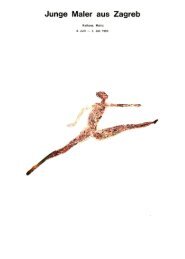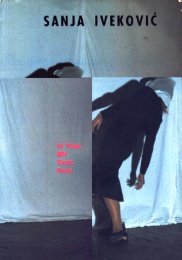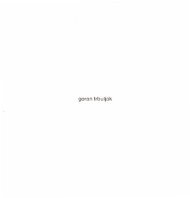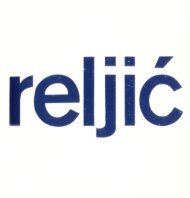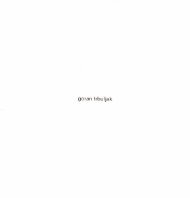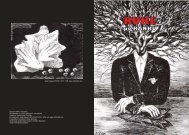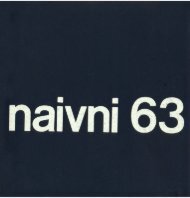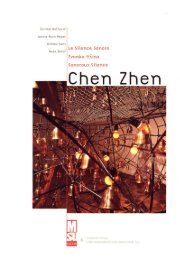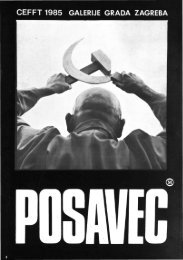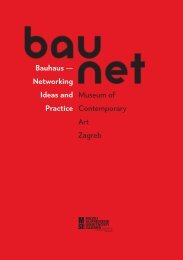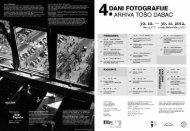The New Art Practice in Yugoslavia, 1966-1978
The New Art Practice in Yugoslavia, 1966-1978
The New Art Practice in Yugoslavia, 1966-1978
- TAGS
- practice
- yugoslavia
- www.msu.hr
You also want an ePaper? Increase the reach of your titles
YUMPU automatically turns print PDFs into web optimized ePapers that Google loves.
Ratomir Kuli, Vladimir Mattioni<br />
Verbumprogram<br />
Belgrade<br />
Fig. 271<br />
<strong>The</strong> pr<strong>in</strong>ciples determ<strong>in</strong><strong>in</strong>g the scope of the programme are<br />
conta<strong>in</strong>ed <strong>in</strong> the notion of verbum. some of the levels of which<br />
can be represented through levels of <strong>in</strong>determ<strong>in</strong>ation, either <strong>in</strong><br />
the form of methods or of procedures of communication. <strong>The</strong><br />
notion of verbum <strong>in</strong>cludes the orig<strong>in</strong>al pr<strong>in</strong>ciple of all techniques,<br />
while the procedure an activity as such methodologically<br />
constitutes a form of consciousness which is itself a structure<br />
of reality. <strong>The</strong> exhibitional character of the programme is,<br />
therefore methodologically directed towards praxis, as<br />
represent<strong>in</strong>g the mean<strong>in</strong>g and content of communication. If the<br />
<strong>in</strong>tention were made the theme of the exhibition, this would<br />
then be Method that which determ<strong>in</strong>es the character of<br />
the programme as a critical consciousness formed through the<br />
experience of the procedure. In this respect, reality is not<br />
expressed, but created, and the attitude towards creation is<br />
determ<strong>in</strong>ed by a pseudalized view of reality. <strong>The</strong> methodology<br />
synthesizes the moment of signification as the ethical basis<br />
<strong>in</strong> any type of activity. That is why the exhibitional form is<br />
always pseudalized by the character of the exhibited material,<br />
while the totality of such an act should be considered as an<br />
environment structured at a given moment of the programme<br />
process.<br />
As the basic assumption and fundamental view of the artist,<br />
the methodology is expla<strong>in</strong>ed by the environmental character<br />
(the material is put together for a specific exhibition) <strong>in</strong> which<br />
the documentation as well as the exhibitional character itself<br />
are pseudalized, and the whole activity is pseudalized <strong>in</strong> the<br />
form of programme activity. Though the exhibitional character<br />
is a simulation, only the form of the exhibition, as reveal<strong>in</strong>g the<br />
attitude of the artist, must be regarded as that which identifies<br />
a work with<strong>in</strong> the framework of the system of art. We do not<br />
aspire to present a totally new idea, but what we do want to<br />
put forth is an <strong>in</strong>novative attitude <strong>in</strong> art, which consists of<br />
praxis, methodologically worked out, which represents a<br />
critical basis <strong>in</strong> communication. Thus we are no longer<br />
condemned (not to the same extent) to the duty of the artistic<br />
vocation which requires that one prove oneself through<br />
production as this determ<strong>in</strong>es the existence of the artistic<br />
personality. <strong>The</strong> method offers us at every moment (<strong>in</strong>spiration)<br />
a way <strong>in</strong> which to structure our attitude towards any form of the<br />
phenomenologically viewed consciousness. Every experience<br />
is unobjective without its transcendental frame, which confirms<br />
the validity of the methodology of comprehend<strong>in</strong>g and act<strong>in</strong>g,<br />
and the only th<strong>in</strong>g that keeps us from achievement is<br />
pseudalization, as a methodological attitude towards all<br />
creations of the m<strong>in</strong>d, towards all <strong>in</strong>stitutional activities, etc.<br />
Thus, we methodologically express our ego cogito <strong>in</strong><br />
transcendence as an existent reality, the existence of which is<br />
noted as pure praxis. For this reason, we can no longer speak<br />
of the process of praxis as someth<strong>in</strong>g that exists someth<strong>in</strong>g<br />
that is. For the duration of praxis can anly be determ<strong>in</strong>ed<br />
<strong>in</strong>tentionally. In this respect, each further step of «the<br />
programme. is realized as the unmask<strong>in</strong>g of the very<br />
<strong>in</strong>tentionality.<br />
<strong>The</strong> fact that we have made an option <strong>in</strong> choos<strong>in</strong>g<br />
communication (art) does not determ<strong>in</strong>e the scope of the<br />
programme, but only the pattern with<strong>in</strong> the framework of<br />
which the totality (be<strong>in</strong>g) is experienced as separated from<br />
that to which it is addressed (thought, activity) and which, <strong>in</strong><br />
its search for identity regards itself as the basis of reality<br />
(fiction). Pseudalization <strong>in</strong> determ<strong>in</strong><strong>in</strong>g the basis of reality is<br />
opposed to all comprehension and <strong>in</strong>terpretation.<br />
To approach the spritual (<strong>in</strong> art) and thereby the supra-<br />
-<strong>in</strong>dividual means to leave the field of expression, and this<br />
means to become <strong>in</strong>different to both the emotional and cultural<br />
contents <strong>in</strong> one's phenomenological course. To express oneself<br />
as clearly as possible means not to express oneself at all, which<br />
means to be objective (objectified). Pure spirituality is possible<br />
only once we become methodologically objective (objectified).<br />
This achievement is preceded by emotional purity «a void..<br />
Different attempts at production, as represent<strong>in</strong>g that which is<br />
(illusion), br<strong>in</strong>g to the fore the completion and delimitation of<br />
that which is not (state), which is a totality. Directly. Yet, it is<br />
not a k<strong>in</strong>d of noth<strong>in</strong>gness (state), nor is it someth<strong>in</strong>g else,<br />
but it appears at the presence of Existence. This presence or<br />
omnipresence will depend on the explanation (Procedure) of<br />
that <strong>in</strong> which the totality is absent (illusion).<br />
Thus, the verbumprogram appears as a process throw<strong>in</strong>g light<br />
on that which, <strong>in</strong> its manifestation, becomes separated from its<br />
basis, i.e. on that which <strong>in</strong> the manifestation itself is ever<br />
present. It is not knowledge, nor is it a po<strong>in</strong>t of support but<br />
rather a state of cont<strong>in</strong>ual reflection.<br />
69



